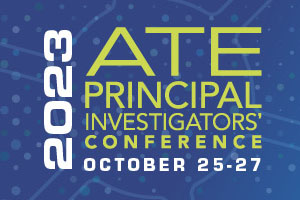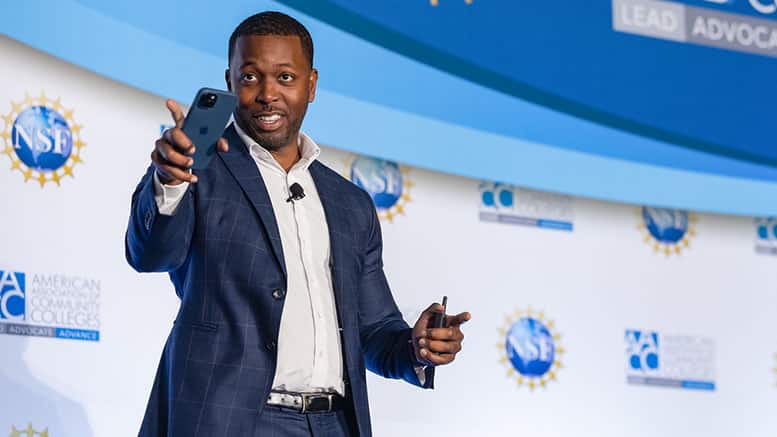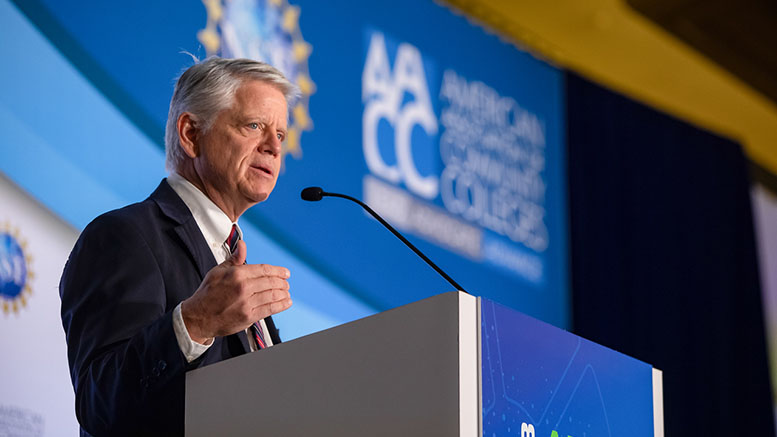Community college educators have the potential to be part of big opportunities from the CHIPS and Science Act’s workforce development funding and advancements in artificial intelligence (AI).

However, accessing new large sources of federal funds and maximizing AI will require not only more hard work but different thinking, according to two plenary speakers at Friday’s closing session of the 2023 Advanced Technological Education Conference. in Washington, D.C.
Scott Jensen, director of workforce strategy for CHIPS at the U.S. Department of Commerce, said the nation needs to double its semiconductor workforce and triple the number of graduates in semiconductor-related fields. The Creating Helpful Incentives to Produce Semiconductors (CHIPS) legislation has $280 billion in funding, with $52.7 billion for American semiconductor research, development, manufacturing and workforce development.
“We are going to need to dig a lot deeper in every community in this country to find people who have the talents and the aptitude and the interest to work in one of these fabs and to make sure they are able to do it,” Jensen said.
Multiple goals
The goal of developing a more diverse workforce also extends to the preparation of these enormous semiconductor chip manufacturing facilities: the Commerce Department wants one million more women to join the construction workforce to build the new fabs and suppliers’ facilities.
Jensen said the federal government will soon announce the first round of awards sought by 500 companies in 42 states.
“A CHIPS company will get a lot of money to expand their operations in the United States, and part of the award will be able to be spent on workforce development, broadly construed,” he said, noting that childcare and other worker supports will be allowable costs.
Community colleges’ role?
He said the awards will be structured in ways that require “unparalleled regional partnerships.” The act authorizes $10 billion to invest in regional innovation and technology hubs across the country. How community colleges will fit into these regional efforts is to be determined.
Jensen explained: “If you read the workforce guide for the CHIPS Act, it is a sector-partnership-focused effort. So what it won’t say is exactly which role each partner is going to play. But what it will insist on, and we will insist on, is that the roles are clear and that is going to mean central roles for community colleges across the country. That has to happen. And there have to be clear lines of accountability, rather than simply funding streams that go off into a disorganized effort. So it doesn’t guarantee that any partner is going to be doing any particular role, but it does insist on roles within a sector partnership within a region.”
In response to a question after his speech, Jensen said that “practically speaking” community colleges would be involved in these partnerships, but awardees will not be required to partner with community colleges nor is there a mandate for community colleges to join in CHIPS-related activities.
But, Jensen said, “I wouldn’t be here if community colleges weren’t going to have to play extremely central roles in all of these CHIPS locations.”
More on AI

Dwayne Matthews, a Canada-based educator who created TomorrowNow Learning Lab and has served as an advisor to numerous governments about Industry 4.0 technologies, said that AI is driving massive changes.
“The world is changing dramatically. It’s changing rapidly and we have a fantastic opportunity. I’m wary of the risks, but I’m radically optimistic about the possibilities,” he said.
He stressed to the ATE community that the November 2022 introduction of ChatGPT, the AI-powered language model, was “a dramatic inflection point.” And he asked the hundreds of community college educators in the audience: “What world are you preparing your students for?”
Time to shift our thinking
To him, some of the biggest risks are inertia and continuing to teach using inefficient educational models from the last two centuries. He sees AI and other technologies to enhance cognitive abilities and do more quickly bring people into the world of work, particularly to bring underprivileged, disenfranchised populations “back into the game.”
To unlock the stranded brilliance of these populations and correct the inefficiencies of traditional educational models, Matthews urged community college educators to shift their thinking to optimize for function over form.
“Now is an opportunity to start thinking not about disruptive technologies, but about disruptive models,” he said. “How do we curate and organize all of the different technologies? How can we create new models? And how do we do that while we focus on A) the mission—unlocking stranded brilliance, and B) the function, not the form?”
Co-partners?
Rather than worry about students using AI to write their papers, he explained that a community college in Canada built AI into its remedial writing courses. Students complete micro-writing assignments on their mobile devices. They receive corrections not only from AI, but from instructors and other students in a gamified process that leverages neuroscience.
He also urged educators to leverage AI as co-pilots for mundane tasks.
He closed with these recommendations: “Double down on building the bridge between [the] economy and learning… Leverage the community college brand for speed and upskilling.”
And, Matthews encouraged the ATE educators to “go global” and use technologies to share their expertise to improve the skills and knowledge of students beyond their usual service districts.
He noted that a professor in Canada has 400,000 online students.

